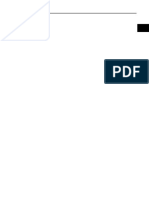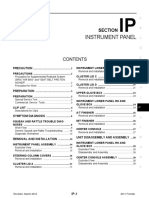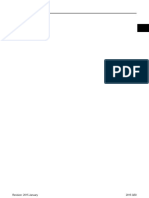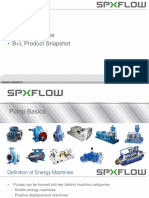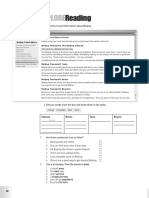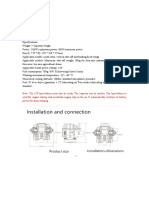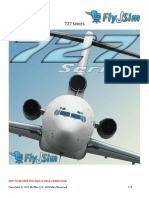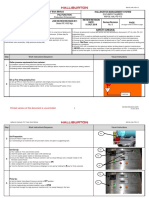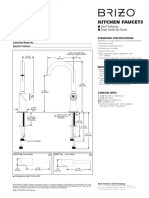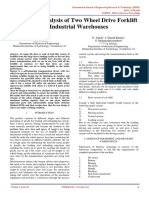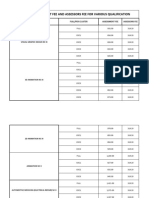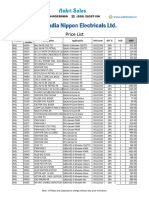Mirrors: Section
Mirrors: Section
Uploaded by
D. UuganbilegCopyright:
Available Formats
Mirrors: Section
Mirrors: Section
Uploaded by
D. UuganbilegOriginal Title
Copyright
Available Formats
Share this document
Did you find this document useful?
Is this content inappropriate?
Copyright:
Available Formats
Mirrors: Section
Mirrors: Section
Uploaded by
D. UuganbilegCopyright:
Available Formats
DRIVER CONTROLS
SECTION MIR MIRRORS
B
E
CONTENTS
PRECAUTION ............................................... 2 MIRROR SWITCH/CHANGEOVER SWITCH : F
Component Inspection .............................................14
PRECAUTIONS ................................................... 2
Precaution for Supplemental Restraint System OPEN/CLOSE SWITCH .............................................15
G
(SRS) "AIR BAG" and "SEAT BELT PRE-TEN- OPEN/CLOSE SWITCH : Component Inspection....15
SIONER" ................................................................... 2
Precautions Necessary for Steering Wheel Rota-
SYMPTOM DIAGNOSIS .............................. 17
H
tion After Battery Disconnection ................................ 2 SQUEAK AND RATTLE TROUBLE DIAG-
Precaution for Procedure without Cowl Top Cover...... 3 NOSES .............................................................. 17
Precautions for Removing Battery Terminal ............. 3
Work Flow ................................................................17
I
PREPARATION ............................................ 4 Inspection Procedure ...............................................19
Diagnostic Worksheet ..............................................21
PREPARATION ................................................... 4
Commercial Service Tools ....................................... 4 REMOVAL AND INSTALLATION ............... 23 J
SYSTEM DESCRIPTION .............................. 5 INSIDE MIRROR ............................................... 23
Exploded View .........................................................23
K
DOOR MIRROR SYSTEM ................................... 5 Removal and Installation .........................................24
Component Description ............................................. 5
DOOR MIRROR ................................................ 26
WIRING DIAGRAM ....................................... 6 Exploded View .........................................................26 MIR
DOOR MIRROR SYSTEM ................................... 6 DOOR MIRROR ASSEMBLY ....................................28
Wiring Diagram ......................................................... 6 DOOR MIRROR ASSEMBLY : Removal and In-
stallation ..................................................................28 M
AUTO ANTI-DAZZLING INSIDE MIRROR
GLASS MIRROR ........................................................30
SYSTEM .............................................................12
GLASS MIRROR : Removal and Installation ...........30 N
Wiring Diagram ....................................................... 12
DOOR MIRROR COVER ...........................................30
DTC/CIRCUIT DIAGNOSIS ......................... 14 DOOR MIRROR COVER : Removal and Installa-
DOOR MIRROR REMOTE CONTROL tion ...........................................................................31 O
SWITCH ..............................................................14 DOOR MIRROR REMOTE CONTROL
MIRROR SWITCH/CHANGEOVER SWITCH ............ 14 SWITCH ............................................................. 32
P
Exploded View .........................................................32
Removal and Installation .........................................32
Revision: 2015 March MIR-1 D23
PRECAUTIONS
< PRECAUTION >
PRECAUTION
PRECAUTIONS
Precaution for Supplemental Restraint System (SRS) "AIR BAG" and "SEAT BELT
PRE-TENSIONER" INFOID:0000000011350244
The Supplemental Restraint System such as “AIR BAG” and “SEAT BELT PRE-TENSIONER”, used along
with a front seat belt, helps to reduce the risk or severity of injury to the driver and front passenger for certain
types of collision. Information necessary to service the system safely is included in the “SRS AIR BAG” and
“SEAT BELT” of this Service Manual.
WARNING:
Always observe the following items for preventing accidental activation.
• To avoid rendering the SRS inoperative, which could increase the risk of personal injury or death in
the event of a collision that would result in air bag inflation, all maintenance must be performed by
an authorized NISSAN/INFINITI dealer.
• Improper maintenance, including incorrect removal and installation of the SRS, can lead to personal
injury caused by unintentional activation of the system. For removal of Spiral Cable and Air Bag
Module, see “SRS AIR BAG”.
• Never use electrical test equipment on any circuit related to the SRS unless instructed to in this Ser-
vice Manual. SRS wiring harnesses can be identified by yellow and/or orange harnesses or harness
connectors.
PRECAUTIONS WHEN USING POWER TOOLS (AIR OR ELECTRIC) AND HAMMERS
WARNING:
Always observe the following items for preventing accidental activation.
• When working near the Air Bag Diagnosis Sensor Unit or other Air Bag System sensors with the
ignition ON or engine running, never use air or electric power tools or strike near the sensor(s) with
a hammer. Heavy vibration could activate the sensor(s) and deploy the air bag(s), possibly causing
serious injury.
• When using air or electric power tools or hammers, always switch the ignition OFF, disconnect the
battery, and wait at least 3 minutes before performing any service.
Precautions Necessary for Steering Wheel Rotation After Battery Disconnection
INFOID:0000000011350243
CAUTION:
Comply with the following cautions to prevent any error and malfunction.
• Before removing and installing any control units, first turn the ignition switch to the LOCK position,
then disconnect both battery cables.
• After finishing work, confirm that all control unit connectors are connected properly, then re-connect
both battery cables.
• Always use CONSULT to perform self-diagnosis as a part of each function inspection after finishing
work. If a DTC is detected, perform trouble diagnosis according to self-diagnosis results.
For vehicle with steering lock unit, if the battery is disconnected or discharged, the steering wheel will lock and
cannot be turned.
If turning the steering wheel is required with the battery disconnected or discharged, follow the operation pro-
cedure below before starting the repair operation.
OPERATION PROCEDURE
1. Connect both battery cables.
NOTE:
Supply power using jumper cables if battery is discharged.
2. Turn the ignition switch to ACC position.
(At this time, the steering lock will be released.)
3. Disconnect both battery cables. The steering lock will remain released with both battery cables discon-
nected and the steering wheel can be turned.
4. Perform the necessary repair operation.
Revision: 2015 March MIR-2 D23
PRECAUTIONS
< PRECAUTION >
5. When the repair work is completed, re-connect both battery cables. With the brake pedal released, turn
the ignition switch from ACC position to ON position, then to LOCK position. (The steering wheel will lock A
when the ignition switch is turned to LOCK position.)
6. Perform self-diagnosis check of all control units using CONSULT.
Precaution for Procedure without Cowl Top Cover INFOID:0000000011350245
B
When performing the procedure after removing cowl top cover, cover
the lower end of windshield with urethane, etc to prevent damage to C
windshield.
PIIB3706J
F
Precautions for Removing Battery Terminal INFOID:0000000011350246
When disconnecting the battery terminal, pay attention to the following.
• Always use a 12V battery as power source. G
• Never disconnect battery terminal while engine is running.
• When removing the 12V battery terminal, turn OFF the ignition
switch and wait at least 30 seconds. H
• For vehicles with the engine listed below, remove the battery termi-
nal after a lapse of the specified time:
D4D engine : 20 minutes YS23DDT : 4 minutes I
HRA2DDT : 12 minutes YS23DDTT : 4 minutes
K9K engine : 4 minutes ZD30DDTi : 60 seconds
M9R engine : 4 minutes ZD30DDTT : 60 seconds
J
R9M engine : 4 minutes
SEF289H
V9X engine : 4 minutes
YD25DDTi : 2 minutes
K
NOTE:
ECU may be active for several tens of seconds after the ignition switch is turned OFF. If the battery terminal
MIR
is removed before ECU stops, then a DTC detection error or ECU data corruption may occur.
• After high-load driving, if the vehicle is equipped with the V9X engine, turn the ignition switch OFF and wait
for at least 15 minutes to remove the battery terminal.
NOTE: M
• Turbocharger cooling pump may operate in a few minutes after the ignition switch is turned OFF.
• Example of high-load driving
- Driving for 30 minutes or more at 140 km/h (86 MPH) or more.
N
- Driving for 30 minutes or more on a steep slope.
• For vehicles with the 2-batteries, be sure to connect the main battery and the sub battery before turning ON
the ignition switch.
NOTE: O
If the ignition switch is turned ON with any one of the terminals of main battery and sub battery discon-
nected, then DTC may be detected.
• After installing the 12V battery, always check "Self Diagnosis Result" of all ECUs and erase DTC. P
NOTE:
The removal of 12V battery may cause a DTC detection error.
Revision: 2015 March MIR-3 D23
PREPARATION
< PREPARATION >
PREPARATION
PREPARATION
Commercial Service Tools INFOID:0000000010554406
Tool name Description
Remover tool Removes clips, pawls and metal clips
JMKIA3050ZZ
Revision: 2015 March MIR-4 D23
DOOR MIRROR SYSTEM
< SYSTEM DESCRIPTION >
SYSTEM DESCRIPTION A
DOOR MIRROR SYSTEM
Component Description INFOID:0000000010563177
B
Component Function
C
It supplies power to mirror motor through mirror switch and changeover
Mirror switch
switch.
Door mirror remote control
Changeover switch It transmits the LH/RH control of door mirror that supplies power.
switch D
Power is supplied to folding mirror from door remote control switch when
Open/close switch
operating switch.
It makes mirror face operate from side to side and up and down via inte- E
Door mirror motor
grated motor.
Door mirror
The door mirror operates because power is received from power supply
Folding motor
when pressing door mirror remote control switch.
F
MIR
Revision: 2015 March MIR-5 D23
DOOR MIRROR SYSTEM
< WIRING DIAGRAM >
WIRING DIAGRAM
DOOR MIRROR SYSTEM
Wiring Diagram INFOID:0000000010562000
LHD MODELS
JRLWE5134GB
Revision: 2015 March MIR-6 D23
DOOR MIRROR SYSTEM
< WIRING DIAGRAM >
MIR
JRLWE7919GB
Revision: 2015 March MIR-7 D23
DOOR MIRROR SYSTEM
< WIRING DIAGRAM >
JRLWE7920GB
Revision: 2015 March MIR-8 D23
DOOR MIRROR SYSTEM
< WIRING DIAGRAM >
RHD MODELS
A
MIR
JRLWE5137GB
P
Revision: 2015 March MIR-9 D23
DOOR MIRROR SYSTEM
< WIRING DIAGRAM >
JRLWE7921GB
Revision: 2015 March MIR-10 D23
DOOR MIRROR SYSTEM
< WIRING DIAGRAM >
MIR
JRLWE7922GB
Revision: 2015 March MIR-11 D23
AUTO ANTI-DAZZLING INSIDE MIRROR SYSTEM
< WIRING DIAGRAM >
AUTO ANTI-DAZZLING INSIDE MIRROR SYSTEM
Wiring Diagram INFOID:0000000011379065
JRLWD8508GB
Revision: 2015 March MIR-12 D23
AUTO ANTI-DAZZLING INSIDE MIRROR SYSTEM
< WIRING DIAGRAM >
MIR
JRLWE7923GB
Revision: 2015 March MIR-13 D23
DOOR MIRROR REMOTE CONTROL SWITCH
< DTC/CIRCUIT DIAGNOSIS >
DTC/CIRCUIT DIAGNOSIS
DOOR MIRROR REMOTE CONTROL SWITCH
MIRROR SWITCH/CHANGEOVER SWITCH
MIRROR SWITCH/CHANGEOVER SWITCH : Component Inspection INFOID:0000000011350206
1.CHECK MIRROR SWITCH & CHANGEOVER SWITCH
1. Turn ignition switch OFF.
2. Disconnect door mirror remote control switch connector.
3. Check door mirror remote control switch.
LHD MODELS
Door mirror remote control switch Condition
Change over Continuity
Terminal Mirror switch
switch
7 10
RIGHT
1 14
7 14
LEFT
1 10
Driver side LEFT
7 16
UP
1 10
7 10
DOWN
1 16
Existed
7 12
RIGHT
1 13
7 13
LEFT
1 12
Passenger side RIGHT
7 15
UP
1 12
7 12
DOWN
1 15
Revision: 2015 March MIR-14 D23
DOOR MIRROR REMOTE CONTROL SWITCH
< DTC/CIRCUIT DIAGNOSIS >
RHD MODELS
Door mirror remote control switch Condition A
Change over Continuity
Terminal Mirror switch
switch
7 12 B
RIGHT
1 13
7 13
LEFT C
1 12
Driver side RIGHT
7 15
UP
1 12 D
7 12
DOWN
1 15
Existed E
7 10
RIGHT
1 14
7 14
LEFT F
1 10
Passenger side LEFT
7 16
UP
1 10 G
7 10
DOWN
1 16
H
Is the inspection result normal?
YES >> INSPECTION END.
NO >> Replace door mirror remote control switch. Refer to MIR-32, "Removal and Installation". I
OPEN/CLOSE SWITCH
OPEN/CLOSE SWITCH : Component Inspection INFOID:0000000011350207
J
1.CHECK OPEN/CLOSE SWITCH
1. Turn ignition switch OFF. K
2. Disconnect door mirror remote control switch connector.
3. Check continuity between door mirror remote control switch terminals under the following conditions.
LHD MODELS MIR
Door mirror remote control switch
Condition Continuity
Terminal
7 3 M
OPEN
1 6
Driver side
7 6
CLOSE N
1 3
Open/close switch Existed
7 2
OPEN
1 5 O
Passenger side
7 5
CLOSE
1 2
P
Revision: 2015 March MIR-15 D23
DOOR MIRROR REMOTE CONTROL SWITCH
< DTC/CIRCUIT DIAGNOSIS >
RHD MODELS
Door mirror remote control switch
Condition Continuity
Terminal
7 2
OPEN
1 5
Driver side
7 5
CLOSE
1 2
Open/close switch Existed
7 3
OPEN
1 6
Passenger side
7 6
CLOSE
1 3
Is the inspection result normal?
YES >> INSPECTION END
NO >> Replace door mirror remote control switch. Refer to MIR-32, "Removal and Installation".
Revision: 2015 March MIR-16 D23
SQUEAK AND RATTLE TROUBLE DIAGNOSES
< SYMPTOM DIAGNOSIS >
SYMPTOM DIAGNOSIS A
SQUEAK AND RATTLE TROUBLE DIAGNOSES
Work Flow INFOID:0000000010562014
B
G
SBT842
CUSTOMER INTERVIEW H
Interview the customer if possible, to determine the conditions that exist when the noise occurs. Use the Diag-
nostic Worksheet during the interview to document the facts and conditions when the noise occurs and any of
the customer's comments; refer to MIR-21, "Diagnostic Worksheet". This information is necessary to duplicate
the conditions that exist when the noise occurs. I
• The customer may not be able to provide a detailed description or the location of the noise. Attempt to obtain
all the facts and conditions that exist when the noise occurs (or does not occur).
• If there is more than one noise in the vehicle, be sure to diagnose and repair the noise that the customer is J
concerned about. This can be accomplished by a test drive with the customer.
• After identifying the type of noise, isolate the noise in terms of its characteristics. The noise characteristics
are provided so the customer, service adviser and technician are all speaking the same language when
K
defining the noise.
• Squeak – (Like tennis shoes on a clean floor)
Squeak characteristics include the light contact/fast movement/brought on by road conditions/hard surfaces
= higher pitch noise/softer surfaces = lower pitch noises/edge to surface = chirping MIR
• Creak – (Like walking on an old wooden floor)
Creak characteristics include firm contact/slow movement/twisting with a rotational movement/pitch depen-
dent on materials/often brought on by activity. M
• Rattle – (Like shaking a baby rattle)
Rattle characteristics include the fast repeated contact/vibration or similar movement/loose parts/missing
clip or fastener/incorrect clearance.
• Knock – (Like a knock on a door) N
Knock characteristics include hollow sounding/sometimes repeating/often brought on by driver action.
• Tick – (Like a clock second hand)
Tick characteristics include gentle contacting of light materials/loose components/can be caused by driver O
action or road conditions.
• Thump – (Heavy, muffled knock noise)
Thump characteristics include softer knock/dead sound often brought on by activity.
• Buzz – (Like a bumble bee) P
Buzz characteristics include high frequency rattle/firm contact.
• Often the degree of acceptable noise level will vary depending upon the person. A noise that a technician
may judge as acceptable may be very irritating to the customer.
• Weather conditions, especially humidity and temperature, may have a great effect on noise level.
DUPLICATE THE NOISE AND TEST DRIVE
Revision: 2015 March MIR-17 D23
SQUEAK AND RATTLE TROUBLE DIAGNOSES
< SYMPTOM DIAGNOSIS >
If possible, drive the vehicle with the customer until the noise is duplicated. Note any additional information on
the Diagnostic Worksheet regarding the conditions or location of the noise. This information can be used to
duplicate the same conditions when the repair is reconfirmed.
If the noise can be duplicated easily during the test drive, to help identify the source of the noise, try to dupli-
cate the noise with the vehicle stopped by doing one or all of the following:
1) Close a door.
2) Tap or push/pull around the area where the noise appears to be coming from.
3) Rev the engine.
4) Use a floor jack to recreate vehicle “twist”.
5) At idle, apply engine load (electrical load, half-clutch on M/T model, drive position on A/T model).
6) Raise the vehicle on a hoist and hit a tire with a rubber hammer.
• Drive the vehicle and attempt to duplicate the conditions the customer states exist when the noise occurs.
• If it is difficult to duplicate the noise, drive the vehicle slowly on an undulating or rough road to stress the
vehicle body.
LOCATE THE NOISE AND IDENTIFY THE ROOT CAUSE
1. Narrow down the noise to a general area. To help pinpoint the source of the noise, use a listening tool
(Engine Ear or mechanics stethoscope).
2. Narrow down the noise to a more specific area and identify the cause of the noise by:
• Removing the components in the area that is are suspected to be the cause of the noise.
Do not use too much force when removing clips and fasteners, otherwise clips and fastener can be broken
or lost during the repair, resulting in the creation of new noise.
• Tapping or pushing/pulling the component that is are suspected to be the cause of the noise.
Do not tap or push/pull the component with excessive force, otherwise the noise will be eliminated only tem-
porarily.
• Feeling for a vibration by hand by touching the component(s) that is are suspected to be the cause of the
noise.
• Placing a piece of paper between components that is are suspected to be the cause of the noise.
• Looking for loose components and contact marks.
Refer to MIR-19, "Inspection Procedure".
REPAIR THE CAUSE
• If the cause is a loose component, tighten the component securely.
• If the cause is insufficient clearance between components:
- Separate components by repositioning or loosening and retightening the component, if possible.
- Insulate components with a suitable insulator such as urethane pads, foam blocks, felt cloth tape or ure-
thane tape. These insulators are available through the authorized Nissan Parts Department.
CAUTION:
Never use excessive force as many components are constructed of plastic and may be damaged.
NOTE:
• URETHANE PADS
Insulates connectors, harness, etc.
• INSULATOR (Foam blocks)
Insulates components from contact. Can be used to fill space behind a panel.
• INSULATOR (Light foam block)
• FELT CLOTHTAPE
Used to insulate where movement does not occur. Ideal for instrument panel applications.
The following materials, not available through NISSAN Parts Department, can also be used to repair
squeaks and rattles.
• UHMW(TEFLON) TAPE
Insulates where slight movement is present. Ideal for instrument panel applications.
• SILICONE GREASE
Used in place of UHMW tape that is be visible or does not fit.
Note: Will only last a few months.
• SILICONE SPRAY
Used when grease cannot be applied.
• DUCT TAPE
Used to eliminate movement.
CONFIRM THE REPAIR
Revision: 2015 March MIR-18 D23
SQUEAK AND RATTLE TROUBLE DIAGNOSES
< SYMPTOM DIAGNOSIS >
Confirm that the cause of a noise is repaired by test driving the vehicle. Operate the vehicle under the same
conditions as when the noise originally occurred. Refer to the notes on the Diagnostic Worksheet. A
Inspection Procedure INFOID:0000000010562015
Refer to Table of Contents for specific component removal and installation information. B
INSTRUMENT PANEL
Most incidents are caused by contact and movement between:
C
1. Cluster lid A and instrument panel
2. Acrylic lens and combination meter housing
3. Instrument panel to front pillar garnish D
4. Instrument panel to windshield
5. Instrument panel mounting pins
6. Wiring harnesses behind the combination meter E
7. A/C defroster duct and duct joint
These incidents can usually be located by tapping or moving the components to duplicate the noise or by
pressing on the components while driving to stop the noise. Most of these incidents can be repaired by apply- F
ing felt cloth tape or silicon spray (in hard to reach areas). Urethane pads can be used to insulate wiring har-
ness.
CAUTION: G
Never use silicone spray to isolate a squeak or rattle. If the area is saturated with silicone, the recheck
of repair becomes impossible.
CENTER CONSOLE H
Components to pay attention to include:
1. Shifter assembly cover to finisher
2. A/C control unit and cluster lid C I
3. Wiring harnesses behind audio and A/C control unit
The instrument panel repair and isolation procedures also apply to the center console.
J
DOORS
Pay attention to the following:
1. Finisher and inner panel making a slapping noise
K
2. Inside handle escutcheon to door finisher
3. Wiring harnesses tapping
4. Door striker out of alignment causing a popping noise on starts and stops MIR
Tapping or moving the components or pressing on them while driving to duplicate the conditions can isolate
many of these incidents. The areas can usually be insulated with felt cloth tape or insulator foam blocks to
repair the noise. M
TRUNK
Trunk noises are often caused by a loose jack or loose items put into the trunk by the customer.
In addition look for the following: N
1. Trunk lid dumpers out of adjustment
2. Trunk lid striker out of adjustment
3. Trunk lid torsion bars knocking together O
4. A loose license plate or bracket
Most of these incidents can be repaired by adjusting, securing or insulating the item(s) or component(s) caus-
ing the noise. P
SUNROOF/HEADLINING
Noises in the sunroof/headlining area can often be traced to one of the following:
1. Sunroof lid, rail, linkage or seals making a rattle or light knocking noise
2. Sunvisor shaft shaking in the holder
3. Front or rear windshield touching headlining and squeaking
Revision: 2015 March MIR-19 D23
SQUEAK AND RATTLE TROUBLE DIAGNOSES
< SYMPTOM DIAGNOSIS >
Again, pressing on the components to stop the noise while duplicating the conditions can isolate most of these
incidents. Repairs usually consist of insulating with felt cloth tape.
SEATS
When isolating seat noise it is important to note the position the seat is in and the load placed on the seat
when the noise occurs. These conditions should be duplicated when verifying and isolating the cause of the
noise.
Cause of seat noise include:
1. Headrest rods and holder
2. A squeak between the seat pad cushion and frame
3. Rear seatback lock and bracket
These noises can be isolated by moving or pressing on the suspected components while duplicating the con-
ditions under which the noise occurs. Most of these incidents can be repaired by repositioning the component
or applying urethane tape to the contact area.
UNDERHOOD
Some interior noise may be caused by components under the hood or on the engine wall. The noise is then
transmitted into the passenger compartment.
Causes of transmitted underhood noise include:
1. Any component mounted to the engine wall
2. Components that pass through the engine wall
3. Engine wall mounts and connectors
4. Loose radiator mounting pins
5. Hood bumpers out of adjustment
6. Hood striker out of adjustment
These noises can be difficult to isolate since they cannot be reached from the interior of the vehicle. The best
method is to secure, move or insulate one component at a time and test drive the vehicle. Also, engine RPM
or load can be changed to isolate the noise. Repairs can usually be made by moving, adjusting, securing, or
insulating the component causing the noise.
Revision: 2015 March MIR-20 D23
SQUEAK AND RATTLE TROUBLE DIAGNOSES
< SYMPTOM DIAGNOSIS >
Diagnostic Worksheet INFOID:0000000010562016
MIR
LAIA0072E
P
Revision: 2015 March MIR-21 D23
SQUEAK AND RATTLE TROUBLE DIAGNOSES
< SYMPTOM DIAGNOSIS >
PIIB8742E
Revision: 2015 March MIR-22 D23
INSIDE MIRROR
< REMOVAL AND INSTALLATION >
REMOVAL AND INSTALLATION A
INSIDE MIRROR
Exploded View INFOID:0000000010491671
B
AUTO ANTI-DAZZLING TYPE
C
JSLIA0428GB
H
Windshield glass Inside mirror base Harness connector
TORX bolt Inside mirror assembly Inside mirror cover
: Pawl I
: N·m (kg-m, in-lb)
: Always replace after every disassembly.
J
MANUAL ANTI-DAZZLING TYPE
K
MIR
JSLIA0509GB
P
Windshield glass Inside mirror base Inside mirror assembly
TORX bolt
: N·m (kg-m, in-lb)
Revision: 2015 March MIR-23 D23
INSIDE MIRROR
< REMOVAL AND INSTALLATION >
Removal and Installation INFOID:0000000010491672
REMOVAL
MANUAL ANTI-DAZZLING TYPE
1. Remove TORX bolt.
2. Slide the inside mirror upward to remove.
AUTO ANTI-DAZZLING TYPE
1. Pull inside mirror cover upper part to disengage it from headlining , and then disengage the lower
part fixing pawls from inside mirror base.
: Pawl
JMLIA3819ZZ
2. Disconnect inside mirror harness connector and remove the
TORX bolt .
JMLIA3818ZZ
3. Slide the inside mirror assembly to the upper side to remove it
from inside mirror base .
CAUTION:
• Never use excessive force to remove the inside mirror
because it is inserted tightly into the inside mirror base.
• Wrap the flat-bladed screwdriver with a shop cloth to avoid
damage on the windshield glass.
JMLIA3820ZZ
JMLIA4291ZZ
INSTALLATION
MANUAL ANTI-DAZZLING TYPE
Install in the reverse order of removal.
AUTO ANTI-DAZZLING TYPE
Note the following items, and then install in the reverse order of removal.
Revision: 2015 March MIR-24 D23
INSIDE MIRROR
< REMOVAL AND INSTALLATION >
• Insert first inside mirror cover lower part fixing pawls.
• Pull up inside mirror cover upper part to and insert it into headlin- A
ing.
: Pawl
B
JMLIA3821ZZ
MIR
Revision: 2015 March MIR-25 D23
DOOR MIRROR
< REMOVAL AND INSTALLATION >
DOOR MIRROR
Exploded View INFOID:0000000010491673
ELECTRICAL TYPE
JMLIA6200GB
Door mirror cover Side turn signal lamp Door mirror housing
Double-sided tape
Glass mirror Door mirror corner cover [t: 4 mm (0.157 in), w: 15 mm (0.59
in), l: 40 mm (1.57 in)]
: Clip
: Pawl
: N·m (kg-m, in-lb)
: Always replace after every disassembly.
MANUAL TYPE
Revision: 2015 March MIR-26 D23
DOOR MIRROR
< REMOVAL AND INSTALLATION >
With door mirror remote control switch
A
I
JMLIA6199GB
Door mirror cover Door mirror housing Glass mirror
J
Double-sided tape
Door mirror corner cover [t: 4 mm (0.157 in), w: 15 mm (0.59
in), l: 40 mm (1.57 in)]
: Clip K
: Pawl
: N·m (kg-m, in-lb) MIR
: Always replace after every disassembly.
Revision: 2015 March MIR-27 D23
DOOR MIRROR
< REMOVAL AND INSTALLATION >
Without door mirror remote control switch
JMLIA6198GB
Double-sided tape
Door mirror assembly Door mirror corner cover [t: 4 mm (0.157 in), w: 15 mm (0.59
in), l: 40 mm (1.57 in)]
: Clip
: Pawl
: N·m (kg-m, in-lb)
: Always replace after every disassembly.
DOOR MIRROR ASSEMBLY
DOOR MIRROR ASSEMBLY : Removal and Installation INFOID:0000000010491674
REMOVAL
CAUTION:
Never damage the body panel.
1. Fully open the front door glass.
2. Remove door mirror corner cover.
Revision: 2015 March MIR-28 D23
DOOR MIRROR
< REMOVAL AND INSTALLATION >
a. Apply protective tape (A) on the part to protect from damage.
A
JSLIA0522ZZ
D
b. Pull out door mirror corner cover upper side to disengage the fix-
ing clip.
E
: Clip
G
JSLIA0393ZZ
c. Disengage door mirror corner cover lower side fixing pawls as
shown by arrow in the figure. H
CAUTION:
Remove double-sided tape remaining on the front door
panel after removing door mirror corner cover. I
: Pawl
JSLIA0394ZZ
K
3. Remove front door finisher. Refer to the following.
• SINGLE CAB: Refer to INT-90, "Removal and Installation"
• DOUBLE CAB: Refer to INT-15, "Removal and Installation". MIR
• KING CAB: Refer to INT-54, "Removal and Installation".
4. Disconnect electrical harness connectors. (if equipped)
5. Remove door mirror housing mounting nuts , and then remove M
door mirror assembly.
JSLIA0395ZZ
P
6. Remove side turn signal lamp. (if equipped) Refer to EXL-165, "Removal and Installation".
INSTALLATION
Note the following items, and install in the reverse order of removal.
CAUTION:
• Visually check clip for deformation and damage during installation. Replace with new ones if neces-
sary.
Revision: 2015 March MIR-29 D23
DOOR MIRROR
< REMOVAL AND INSTALLATION >
• When installing, check in advance that clip and pawls are accurately aligned with the portions on
front door panel, and then install by pressing in.
• If double sided-tape is removed from door mirror corner cover, replace door mirror corner cover with
a new part. Never reuse double-sided tape.
• If the adhesive strength of the double sided-tape is reduced, or if the double sided-tape is damaged,
replace door mirror corner cover.
• When applying double-sided tape and primer, never contact with a grommet.
GLASS MIRROR
GLASS MIRROR : Removal and Installation INFOID:0000000010491676
REMOVAL
1. Place glass mirror upward.
2. Apply protective tape (A) on door mirror housing to protect it
from damage.
JMLIA3162ZZ
3. Remove glass mirror .
a. Insert a remover tool (A) into the recess at lower side between glass mirror and actuator .
b. Disengage the door mirror fixing pawl by pushing up while rotating (twisting) the remover tool (A).
c. Remove by following as shown in the figure below.
JSLIA0414ZZ
4. Remove glass mirror.
INSTALLATION
Note the following item, and then install in the reverse order of removal.
CAUTION:
After installation, visually check that pawls are securely engaged.
DOOR MIRROR COVER
Revision: 2015 March MIR-30 D23
DOOR MIRROR
< REMOVAL AND INSTALLATION >
DOOR MIRROR COVER : Removal and Installation INFOID:0000000010491677
A
REMOVAL
1. Remove glass mirror. Refer to MIR-30, "GLASS MIRROR : Removal and Installation".
B
2. Disengage door mirror cover fixing pawls using a remover tool
according to numerical order 1→8 indicated as shown in the fig-
ure.
C
: Pawl
JSLIA0396ZZ
I
3. Remove door mirror cover from door mirror housing.
INSTALLATION
J
Note the following item, and then install in the reverse order of removal.
CAUTION:
After installation, visually check that pawls are securely engaged.
K
MIR
Revision: 2015 March MIR-31 D23
DOOR MIRROR REMOTE CONTROL SWITCH
< REMOVAL AND INSTALLATION >
DOOR MIRROR REMOTE CONTROL SWITCH
Exploded View INFOID:0000000010585652
Refer to INT-14, "Exploded View" (DOUBLE CAB) or INT-53, "Exploded View" (KING CAB) or INT-89,
"Exploded View" (SINGLE CAB).
Removal and Installation INFOID:0000000010491678
REMOVAL
1. Remove the power window main switch finisher. Refer to PWC-111, "Removal and Installation".
2. Remove door mirror remote control switch from power win-
dow main switch finisher using remover tool (A).
CAUTION:
Apply protective tape (B) around housing to protect the
painted surface from damage.
: Pawl
JSLIA0464ZZ
INSTALLATION
Install in the reverse order of removal.
Revision: 2015 March MIR-32 D23
You might also like
- Engine - VQ25DE and VQ35DE Engine Mechanical PDFDocument148 pagesEngine - VQ25DE and VQ35DE Engine Mechanical PDFscott glacken100% (3)
- Manual Book Transmisi AT Nissan JukeDocument470 pagesManual Book Transmisi AT Nissan JukeWendy Purwanto88% (8)
- Engine Mechanical MR16DDT JukeDocument321 pagesEngine Mechanical MR16DDT JukePascalPedra100% (1)
- Hyundai Santa Fe SM 2001 2006Document1,012 pagesHyundai Santa Fe SM 2001 2006Slobodan100% (1)
- Engine Mechanical: SectionDocument421 pagesEngine Mechanical: SectionАндрей НадточийNo ratings yet
- 2014 Nissan Juke 47748 PDFDocument349 pages2014 Nissan Juke 47748 PDFhidraulic100% (2)
- Qashqai j11 ENGINE COOLING SYSTEMDocument105 pagesQashqai j11 ENGINE COOLING SYSTEMmihaimarton100% (2)
- Pittsburgh (Harbor Freight) 92649 A-C Manifold Gauge Set Quick ReferenceDocument4 pagesPittsburgh (Harbor Freight) 92649 A-C Manifold Gauge Set Quick ReferenceRick McGuire0% (1)
- IB Case BoeingDocument1 pageIB Case BoeingvinayakbelwadeNo ratings yet
- 2013 Nissan Leaf - Mirrors (Section MIR)Document27 pages2013 Nissan Leaf - Mirrors (Section MIR)pos phongsathornNo ratings yet
- Mirrors: SectionDocument25 pagesMirrors: SectionAbraham BravoNo ratings yet
- (NISSAN) Manual de Taller Nissan Cube 2014Document123 pages(NISSAN) Manual de Taller Nissan Cube 2014willy_net123No ratings yet
- Mirrors: SectionDocument17 pagesMirrors: SectionMartin petruNo ratings yet
- Em PDFDocument147 pagesEm PDFCarlos Tito AmésquitaNo ratings yet
- Em Ys23ddtt y Qr25de Np300Document423 pagesEm Ys23ddtt y Qr25de Np300YAIR GAMEZ CASTAÑEDA100% (1)
- Engine Mechanical: SectionDocument379 pagesEngine Mechanical: SectionRifki AwaludinNo ratings yet
- инфинити FX35 VQ35HRDocument293 pagesинфинити FX35 VQ35HRVegamotor VnNo ratings yet
- Nissan NP300 Engine MechanicalDocument289 pagesNissan NP300 Engine MechanicalCarlos Zuniga100% (8)
- Nissan - Juke - Model - F15 - Series 2Document360 pagesNissan - Juke - Model - F15 - Series 2Engr Ko VictorNo ratings yet
- Em PDFDocument101 pagesEm PDFwan motor motorNo ratings yet
- NP300Document422 pagesNP300Carlos FegliaNo ratings yet
- Mecanica Del Motor 370 ZDocument153 pagesMecanica Del Motor 370 Zisrael martinezNo ratings yet
- EM TeanaDocument273 pagesEM TeanaJuan Carlos Condori CarrilloNo ratings yet
- Windows GlassDocument28 pagesWindows GlassMuhammad Ihwan AnshoriNo ratings yet
- Engine Mechanical: SectionDocument146 pagesEngine Mechanical: Sectionjorge Angel LopeNo ratings yet
- Exterior: SectionDocument46 pagesExterior: Sectionjair HernandezNo ratings yet
- Mir 2014 2021 Nissan Xtrail Service ManuDocument33 pagesMir 2014 2021 Nissan Xtrail Service ManucevazcorNo ratings yet
- Engine Mechanical: SectionDocument255 pagesEngine Mechanical: SectionRodrigomsoaresNo ratings yet
- SRS-JUKE-2016-FILE4CARS.COM(1)Document32 pagesSRS-JUKE-2016-FILE4CARS.COM(1)reza mohamadtabarNo ratings yet
- Glass & Window System: SectionDocument29 pagesGlass & Window System: SectionJose Perdomo OrellanaNo ratings yet
- Engine Cooling System: SectionDocument27 pagesEngine Cooling System: SectionCarlos Tito AmésquitaNo ratings yet
- Em-Engine MechanicalDocument306 pagesEm-Engine MechanicalДенис БабининNo ratings yet
- Srs Airbag: SectionDocument34 pagesSrs Airbag: Sectionratatrampa25No ratings yet
- Em PDFDocument141 pagesEm PDFTESA MOTORSNo ratings yet
- Engine Mechanical: SectionDocument128 pagesEngine Mechanical: Sectionsalusfrank100% (1)
- Mirrors: SectionDocument41 pagesMirrors: SectionFaust100% (1)
- Steering System: SectionDocument47 pagesSteering System: SectionLíder DieselNo ratings yet
- Mirrors: SectionDocument33 pagesMirrors: SectionАндрей НадточийNo ratings yet
- CVT Juke Re0f11aDocument513 pagesCVT Juke Re0f11aAndika SetiyawanNo ratings yet
- Engine Cooling System: SectionDocument88 pagesEngine Cooling System: SectionvertNo ratings yet
- Exterior: SectionDocument29 pagesExterior: SectionhuusonbachkhoaNo ratings yet
- Engine Mechanical: SectionDocument149 pagesEngine Mechanical: SectionRuhu royNo ratings yet
- Int PDFDocument40 pagesInt PDFMisha KulibaevNo ratings yet
- Engine Mechanical: SectionDocument332 pagesEngine Mechanical: SectionDrew ThompsonNo ratings yet
- Exterior: SectionDocument34 pagesExterior: SectionWilmer Elias Quiñonez HualpaNo ratings yet
- Interior: SectionDocument70 pagesInterior: SectionLíder DieselNo ratings yet
- 50 Manual Nissan Sentra 2013Document276 pages50 Manual Nissan Sentra 2013David100% (2)
- Engine - VQ25DE and VQ35DE Cooling System PDFDocument27 pagesEngine - VQ25DE and VQ35DE Cooling System PDFscott glackenNo ratings yet
- Em PDFDocument339 pagesEm PDFEdgardoCadaganNo ratings yet
- X-Trail CoolingDocument88 pagesX-Trail CoolingMed Baz100% (4)
- Engine Mechanical Infiniti Q50 VR30Document163 pagesEngine Mechanical Infiniti Q50 VR30LucasNo ratings yet
- g37s PDFDocument311 pagesg37s PDFalex assNo ratings yet
- Steering System: SectionDocument40 pagesSteering System: SectionOvidiu EsanuNo ratings yet
- Mirrors: SectionDocument22 pagesMirrors: SectionALexis IbacetaNo ratings yet
- CO - 2008 Nissan Rogue FSM - Engine Cooling SystemDocument28 pagesCO - 2008 Nissan Rogue FSM - Engine Cooling SystemUgauggaNo ratings yet
- IP - FronDocument31 pagesIP - FronIvan A. VelasquezNo ratings yet
- Brake System: SectionDocument110 pagesBrake System: SectionJumadi AlkutsNo ratings yet
- CO - Cooling SystemDocument88 pagesCO - Cooling SystemJorge LainezNo ratings yet
- Infiniti Q50 2015 Service Manual - Engine Mechanical (Section EM)Document166 pagesInfiniti Q50 2015 Service Manual - Engine Mechanical (Section EM)Zvevanjanja Izvi TechnologiesNo ratings yet
- Nissan-Murano 2015 EN Motor E137da4f0cDocument147 pagesNissan-Murano 2015 EN Motor E137da4f0cabdullahgilan60No ratings yet
- Brake System: SectionDocument65 pagesBrake System: SectionRuhu royNo ratings yet
- Powerboat Handling Illustrated: How to Make Your Boat Do Exactly What You Want It to DoFrom EverandPowerboat Handling Illustrated: How to Make Your Boat Do Exactly What You Want It to DoRating: 4.5 out of 5 stars4.5/5 (6)
- Wosawat (Tiger) Ratsameeveeranitchakul: 505 Lock ST W, Dunnville, Ontario, N1A 1V8Document7 pagesWosawat (Tiger) Ratsameeveeranitchakul: 505 Lock ST W, Dunnville, Ontario, N1A 1V8StephenNo ratings yet
- CSP0000160-01 Table of ContentsDocument12 pagesCSP0000160-01 Table of ContentsA̶l̶x̶a̶n̶d̶e̶r̶ PaniNo ratings yet
- WA320-5 S/N 60001-UP: Cut-Off ValveDocument1 pageWA320-5 S/N 60001-UP: Cut-Off Valveeshopmanual limaNo ratings yet
- Flyscooters SwiftManualDocument42 pagesFlyscooters SwiftManualverkacktNo ratings yet
- 1 - Pump BasicDocument46 pages1 - Pump Basicriin100% (1)
- Expolre Reading 6 A 1Document1 pageExpolre Reading 6 A 1Christian David Rodriguez GNo ratings yet
- Introduction To Materials HandlingDocument40 pagesIntroduction To Materials HandlingskjonsbytNo ratings yet
- TYREDocument89 pagesTYREkaswade BrianNo ratings yet
- V7 III - V7 III Stone Night Pack 750 (2019) PDFDocument24 pagesV7 III - V7 III Stone Night Pack 750 (2019) PDFPaduraru FlorinNo ratings yet
- Spezialnähmaschine: BetriebsanleitungDocument18 pagesSpezialnähmaschine: BetriebsanleitungFerney RamirezNo ratings yet
- What Is The Difference Between Dln-1 & Dln-2? Like ReplyreportDocument49 pagesWhat Is The Difference Between Dln-1 & Dln-2? Like ReplyreportSahariar Bin Shafique100% (3)
- F6000 English ManualDocument12 pagesF6000 English ManualJuan Alberto Saldaña Quiroz100% (1)
- FJS-727 SeriesManouversManualDocument9 pagesFJS-727 SeriesManouversManualDave91No ratings yet
- COMPUTER DATA LINES - Honda Civic Hybrid 2005 - SYSTEM WIRING DIAGRAMSDocument3 pagesCOMPUTER DATA LINES - Honda Civic Hybrid 2005 - SYSTEM WIRING DIAGRAMSbazucaNo ratings yet
- EDE Micro Project 2Document13 pagesEDE Micro Project 2Shri SalokheNo ratings yet
- Moto Guzzi V100 ManualDocument192 pagesMoto Guzzi V100 ManualAndreu FarréNo ratings yet
- Catalog Isuzu Elf Euro 2 NKR 55Document5 pagesCatalog Isuzu Elf Euro 2 NKR 55excelmin338100% (1)
- 7270 1000 Eng TM PDFDocument1 page7270 1000 Eng TM PDFJordanNo ratings yet
- Quality/Critical Checks: Safety ChecksDocument5 pagesQuality/Critical Checks: Safety ChecksCynthy Ivonne Torres PerezNo ratings yet
- BSP-K-61075LF-LHP Rev ADocument1 pageBSP-K-61075LF-LHP Rev ALa Rinconada HuepacNo ratings yet
- Iso ChecklistDocument37 pagesIso ChecklistVikas RayNo ratings yet
- Data Spare Part DatangDocument7 pagesData Spare Part DatangThaufan WijayaNo ratings yet
- 2 Wheel Drive Forklift For Industry WarehousesDocument5 pages2 Wheel Drive Forklift For Industry WarehousesSuyog MhatreNo ratings yet
- 45 AS-F-HSE 045 - Inspection Report TrucksDocument2 pages45 AS-F-HSE 045 - Inspection Report TrucksJHUPEL ABARIAL100% (3)
- Updated Assessment Fee and Assesors Fee As of June 2022Document27 pagesUpdated Assessment Fee and Assesors Fee As of June 2022Goldtown TechnologicalNo ratings yet
- INE ListDocument8 pagesINE Listak autopartsNo ratings yet
- Horno Garland SGCDocument18 pagesHorno Garland SGCVictor Hugo Quiñonez QuintanaNo ratings yet




















